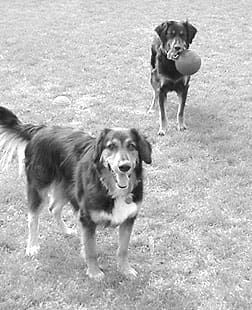In the June 2000 issue, the weight-loss article (“A Weighty Issue”) suggested using vegetables as a low-calorie, high-fiber filler for the dog. But I was dismayed to see onions on the list of vegetables that could be added to the dog’s food! It’s my understanding that onions are poisonous to dogs.
-Maryann Yuran
Phillipsburg, NJ

You’re quite right; too many onions can cause a condition called “Heinz body anemia” in dogs, and though it actually takes quite a whopping dose of onions to cause harm, they are not recommended for dogs in any amount. An editing error saw the inclusion of onions on the list of vegetables that can be added to a dog’s diet. We apologize for the error.
Dr. Richard Pitcairn states that chopped parsley, alfalfa sprouts, finely grated carrots, and finely grated zucchini are dogs’ favorite raw vegetables, and corn, peas, green beans, and broccoli are best fed cooked.
——–
I have two dogs that I walk together, including a large, strong Border collie-Chow mix named Bear, who used to practically pull my arms off on every walk. I can’t count the times I have eaten mulch when he’s caught me off balance. My big, 21-year-old son could control him, but Bear was tough even for him.
I was working on getting Bear used to a head halter according to your article’s day-by-day instructions (“Head Halters, Right and Wrong,” June 2000), when a friend told me her Chow-mix had also been a strong puller, but stopped pulling almost entirely when they walked her with a body halter. Since Bear really protested the head halter, I tried the body halter, and it worked. My teeth have been dirt-free ever since! Bear still pulls a little, but he is very controllable, even for me. I’m not sure what the brand is, but it works well for me.
-Krista Gimeno
Manassas, VA
Pat Miller reviewed anti-pulling collars and harnesses in the July 1998 issue. She, too, found a harness (the Holt Control Harness) that she thought worked very well for many dogs. However, she also warned readers away from another product, the Pro-Stop! Harness, which had straps that encircled the dog’s front legs; she found that most dogs were simply befuddled by the intense pressure applied by this harness.
Stay tuned; we’ll be looking at the newest crop of no-pull training products in an upcoming issue of WDJ.
——–
I have several dogs and I walk two on head halters because they are incorrigible pullers. Your article on head halters mentioned the fact that some dogs can pull a head halter off; this has happened to me. Once it was because the plastic buckling mechanism broke, and once because the dog pulled it over the back of her head, not off her nose. Both times the dog was truly loose but, thanks to good training, came straight to me when called.
One of my girls is a real Houdini as well as a puller, so I didn’t want to give up on the head halter idea. Since I walk all my dogs together, using extra leashes was not an option. However, a simple coupler, usually marketed as a way to walk two dogs with one leash, proved a perfect solution. I clip the dog’s leash to the “O-ring” in the center of the coupler and then snap one end of the coupler to the Halti and the other to the dog’s regular collar. Problem solved.
-Theresa Szpila
Sunnyside, NY
As a veterinary dermatologist in Southern California, I recently had the opportunity to read one of your articles, “WDJ’s Top 10 Dry Dog Foods” (February 2000). A client asked for my opinion regarding some of the topics within the article. While I would agree and disagree with various points, I respect the fact that there are many differing opinions regarding nutrition and food values by different people. Some of these are based on bias, others on experience, while others on scientific merit.
While nutrition is not my specialty (I bow to those with superior knowledge of that area), dermatology and dermatologic disease is and I would like to address a statement made regarding food allergy in dogs.
Like many clients, your article made the statement that “there are more dogs that are allergic to wheat and corn” than any other dog food ingredients. While this is a commonly held belief, there is no basis for it in fact. While food allergies are themselves often diagnosed, their prevalence in the general population of dogs is believed to be quite low among dermatologists. Part of this is a result of the confusion between food allergy and food intolerance.
Food allergy, as I am sure you are aware, is a situation in which there is an immunologic response to a protein or carbohydrate (most commonly). This immunologic response involves a hypersensitivity type reaction (either Type I or Type IV) and results in increased pruritus and often secondary infections.
In contrast, a food intolerance is a non-immunologic reaction to a food or food component which generally results in gastrointestinal disturbances of various types. Many clients will report that their dog is “allergic” to a certain food because it vomits or has other gastrointestinal disease present while, in fact, it is strictly a food intolerance. Without appropriate food trials and rechallenge of individual ingredients to confirm a hypersensitivity reaction, food allergy is difficult at best to diagnose.
When those challenges are done, the results are often surprising. Dr. Phil Roudebush, a respected member of the veterinary dermatology community, recently completed a complete review of the veterinary literature of the last 30 years. He consolidated the information for all confirmed food allergy dogs in the literature that had been rechallenged and verified.
His results showed only 253 cases in the literature. Of these, beef accounted for 81, dairy for 50, wheat for 40, chicken for 18, eggs for 18, lamb for 13 and soy for 3. There were a few other miscellaneous reactions, but those numbers were minimal. This generally concurs with the clinical implication of most dermatologists that beef, chicken, dairy and wheat are more common than most. So, while wheat may have more numbers than many, it is certainly not the most common reactive ingredient.
On the other hand, corn (though commonly assumed to be implicated) cannot be proven based on the literature available. In my clinical practice, I have seen a few corn allergies, however, those numbers pale in comparison to most other ingredients. Corn would fall under a second category of “food stuffs commonly implicated but rarely confirmed.” This would include things such as additives, preservatives, rice, and potato.
The veterinary communities understanding of foods and food allergy has come a long way and I am sure will continue to evolve of time. Everyone’s interest and input is important and I appreciate the hard work you do in attempting to educate your readers about their pets.
-Rusty Muse DVM, ACVD
Animal Dermatology Clinic
Tustin, CA






